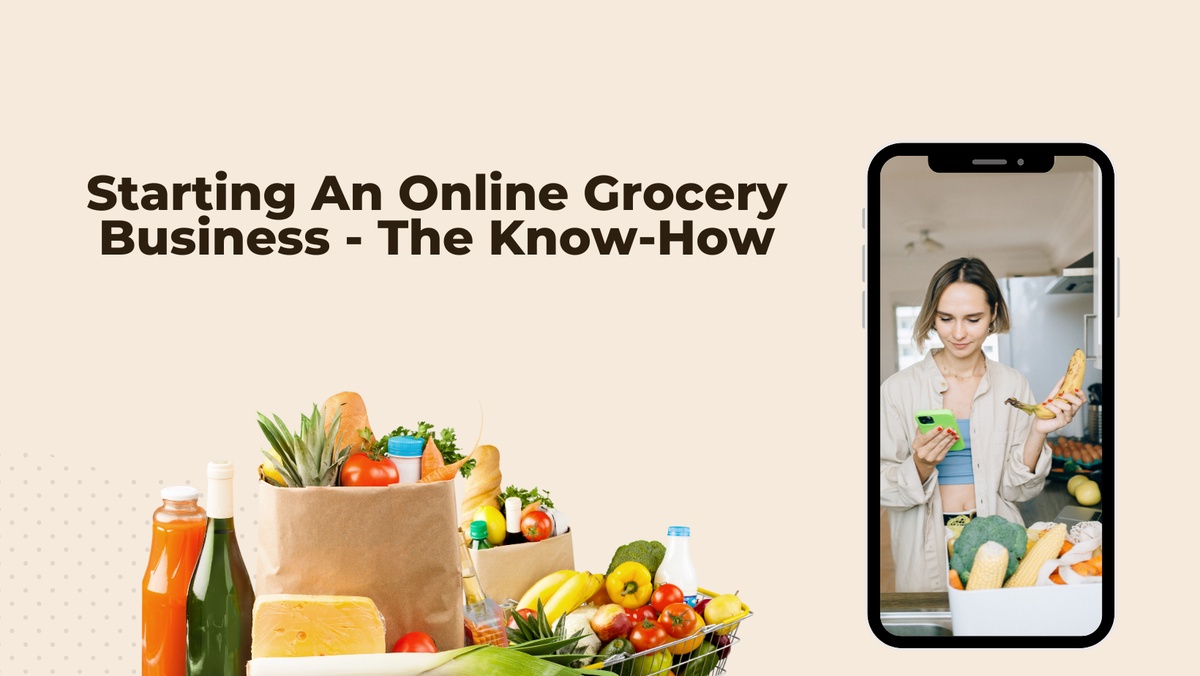Since the global outbreak of Covid, individuals have been avoiding crowded places like supermarkets and shopping centers to some extent. It was during that time, online grocery businesses generated a substantial amount of interest. Thus, online grocery shopping became the norm. Even after the outbreak was contained, online grocery businesses managed to gain a foot-hold because of the guarantee of quick, hassle-free delivery to the doorstep of consumers.
That said, the global online grocery market is anticipated to reach USD 807.8 Billion in value by 2026, growing at a CAGR of 23.4% between 2020 and 2026.
In this blog, we will discuss various business models, potential revenue methods, and the benefits of the online grocery business.
What is an Online Grocery Business?
Grocery shopping is an essential errand to run for every household. But with the emergence of new technologies, people can buy groceries at their convenience without having to take time from their busy lives and go to the grocery store. Online grocery businesses provide a seamless online shopping experience using a web-based shopping service. Customers can get the order delivered to their doorstep hassle-free by selecting the time slot and the delivery option.
What are the Benefits of Online Grocery Business?
For entrepreneurs planning to start an Online Grocery Business, some of the benefits are :
- The management of vendors & products,
- Multiple revenue streams such as membership subscription, commission, and much more.
What are the various Online Grocery Business Models?
Business Models decide how the business generates, distributes, and monetizes value. This section covers some business models, entrants can use to launch online grocery businesses.
Inventory-Based Business Model
In an inventory-based business model, the marketplace owner/admin holds the inventory from numerous vendors. The admin makes the purchases and keeps the products in the warehouse. Further, it is from the warehouse that ordered items are shipped and delivered.
Pros and Cons of the Inventory Model
- The inventory model provides effective inventory control, order fulfillment, quality assurance, and prompt delivery.
- The Inventory based business model can be expensive.
- The items can have a high fixed cost.
- Difficult to scale.
Fresh Direct is one of the inventory-based grocery platforms. It handles deliveries for thousands of customers, including pharmacies, e-commerce firms, supermarkets, and more.
Multi-vendor Marketplace Business Model
The multi-vendor marketplace business model refers to the business strategy whereby a centralized platform is offered to numerous sellers so they may connect with potential customers and sell their goods.
This strategy exempts e-commerce marketplaces from storing inventory and providing order fulfillment services. Sellers have complete control over the fulfillment process, including controlling inventory, setting prices, packing products, and shipping them to customers.
Pros and cons of the Inventory Model
- Well-developed customer base.
- Marketplaces are in charge of the platform and logistics, and sellers manage items, giving them greater control over the supply chain.
- Zero-Inventory reducing operational cost.
One of the difficulties multi-vendor shop managers confront is maintaining product prices and margins.
Peapod is one example of the multi-vendor-led marketplace business model. It is one of the American grocery delivery services.
Hyperlocal Grocery Business Model
A Hyperlocal Delivery Model is a business model that responds to people's needs in their immediate surroundings. Using a digital platform, local retailers provide groceries, such as prescription drugs, alcohol, food, and beverages. Contrary to e-commerce, hyperlocal delivery guarantees same-day delivery within a few hours or minutes. This is a hyperlocal delivery service's unique selling proposition (USP).
Pros and cons of the Hyperlocal Model
- Sustainable as there is no long transportation that reduces the carbon footprint.
- Supports local Businesses.
- Single Platform manages the entire market in one place.
- Difficulty in expansion as the target audience is from a set geographical area.
- Competition for exclusivity.
Shipt is one such platform that delivers fresh groceries from local stores.
BOPIS (Buy Online Pickup In-Store Business Model)
BOPIS, referred to as click and collect, stands for "Buy Online Pick-up In-Store." Online buyers can browse products on an e-commerce website and place an order for pick-up in a nearby store using this omnichannel fulfillment strategy.
Customers can skip time-consuming in-store browsing sessions by using the BOPIS fulfillment option, which also confirms that an item is ready for purchase.
Pros and cons of the Buy Online Pickup In-Store Model
- Reduced Shipping cost.
- In-stock assurance of the item.
- The abandonment rate of the cart is lower.
- Quick Service as wait time in the store is reduced.
- Managing Inventory, commissions, and returns is complex.
Target is an example of the buy online pickup in-store model.
What are the Revenue Streams of an Online Grocery Business?
A company's online presence offers several opportunities for income generation and monetary stability. The online grocery business has a variety of revenue-generating channels, including
-
Commission on Transactions
The marketplace owner charges a fee for each transaction from the vendor/seller. Using this money stream, the admin can profit from the marketplace.
-
Commission on Delivery
The marketplace owner receives a percentage of the money the delivery person receives after completing the order. Additionally, the buyer is charged a fraction for shipping the ordered goods.
-
Banner Ads and Promotions
The marketplace owner can charge sellers to advertise their shop or products on the homepage via banner advertisements or other schemes like website advertisements.
-
Vendor subscription
Also known as a membership fee. The vendor can pay a subscription fee yearly or quarterly to avoid paying the commission on every order.
Conclusion
Online grocery has expanded quickly, and the number of competitors in the market has grown, although the industry is still in its developmental stages. Retailers who move decisively and invest strategically now will be well-positioned to carve out a successful and sustainable market position in the future. You may create a fully scalable online grocery marketplace using Growcer, an online grocery software. Growcer offers ready-made apps for both buyer and the delivery staff at a one-time cost, along with a year of no-cost technical assistance.
For more information and assistance feel free to contact.


No comments yet